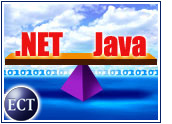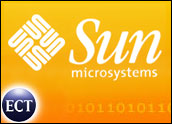
In a move intended to attract Java developers, Microsoft on Monday released a new programming tool that rounds out its .NET software strategy.
Microsoft launched Visual J# .NET, a development tool designed to be used by Java-language developers building applications and services on the .NET framework. The tool complements Visual C++ .NET, Visual C# .NET and Visual Basic .NET.
Integration and Productivity
Microsoft executives claim Visual J# .NET provides an easy transition into the world of XML web services for Java developers, and improves the interoperability of Java programs with existing software written in several other programming languages.
Web services — still a nascent market in the process of defining new ways to employ the Internet as a development platform — gives enterprises maximum interoperability across disparate systems and platforms.
“Today, Java-language developers can increase their productivity while building and deploying agile, interoperable XML Web services,” said Tom Button, vice president of Microsofts developer and platform evangelism division. “With Visual J# .NET, we’re helping our customers solve the complex problem of integration.”
Gaining Momentum
Analysts said Microsofts announcement helps sustain momentum in a software market that is slowly moving forward.
“It’s important for Microsoft to get everything together and continue to deliver on the vision,” Yankee Group analyst Robert Perry told the E-Commerce Times. “It provides confidence for organizations that have committed to .NET that it’s real and that all the pieces are falling into place.”
Still, Perry does not anticipate any major impact on Java. Enterprises are still choosing development camps, and, for that matter, still trying to understand where Web services fits into their IT strategies.
Watching Web Services
Web services so far is still in something of an experimental phase. IT investment today is primarily business initiative-driven, rather than technology-driven. And despite Microsofts attempts to solve interoperability issues, IT departments must see it before they will believe it.
“IT needs to have a lot more confidence that this is going to [be] as interoperable as has been stated,” said Perry. “Theres a lot more that has to be developed in the way of education and understanding, and some infrastructure issues, too.”
Migrating to Visual J#
Still, Microsoft executives are bullish about its completed suite of .NET tools, predicting that 12 to 15 percent of all Java developers will use Visual J# within a year.
“Microsoft wants to regain some of the lost Java developers,” said Perry. “The company will do whatever it can do to make its development tools better and make it easier for Java developers to come back and use the Microsoft tool set.”
To advance that goal, Microsoft has made some improvements to Visual J# .NET, such as better documentation and sample code to help educate programmers. These and other improvements, said analysts, should benefit the company and its customers.
Sun Block
Microsofts competitors include Sun, IBM, Oracle and BEA Systems, all of which support a competing Java standard.
Sun filed an antitrust lawsuit against Microsoft in March, alleging that the company denied the Java platform’s access to Microsoft’s distribution channels.
So, why does Microsoft seem to have a need to go against the industry flow?
“Java came against their flow,” said Perry. “Microsoft had its C development tools and Java was essentially invented to go against it.”
“I dont see why Microsoft needs to jump on that bandwagon.”












































Social Media
See all Social Media